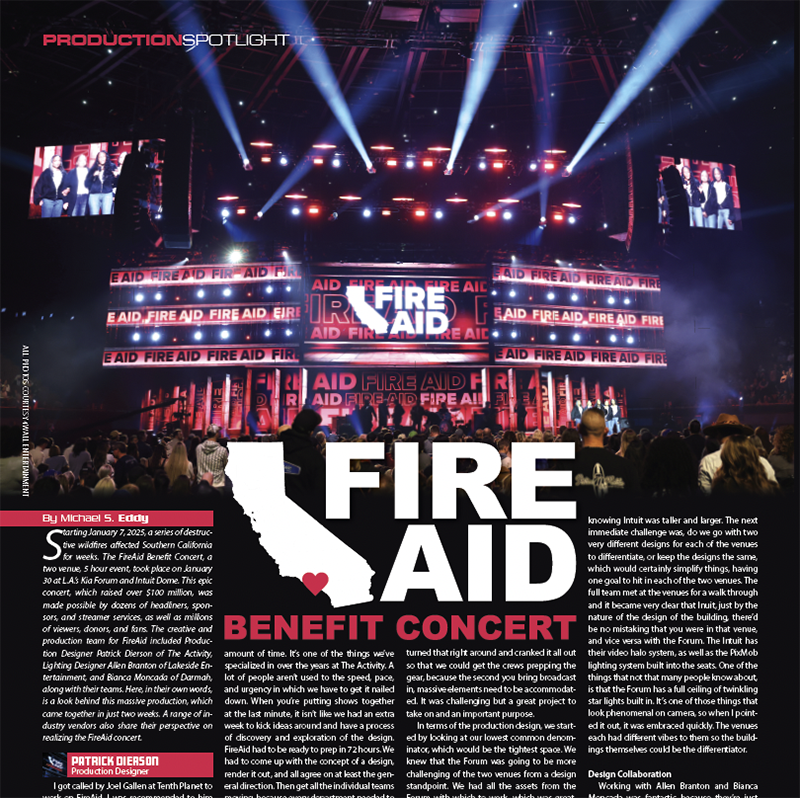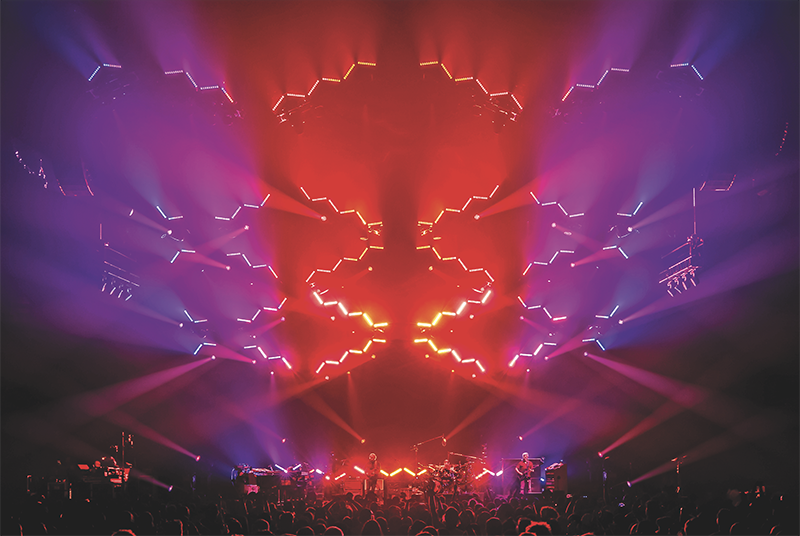
Chris Kuroda has logged 35 years as the Lighting Designer for Phish, having lit well over 1,700 shows since he joined them in 1989. Each show of the long-running rock band has no set list which means Kuroda and his Associate Lighting Designer/Programmer, Andrew Giffin, along with Madison Wade the Automation Programmer, are improvising the lighting and rig automation each performance. PLSN spoke with Kuroda and Giffin, as well as Gateway Studios & Production Services CEO / Phish Video Director Trey Kerr, and Production Manager Jesse Sandler about their being part of this amazing, seemingly, never-ending tour.

CHRIS KURODA
Lighting Designer / Director
How do you keep your lighting design new and fresh for the fans?
I’ve always believed that lighting is meant to enhance the experience and not overwhelm or dominate the experience. Every lighting designer has a different style of how they would approach that. Our mantra ever since I’ve been there, has been organic, elegant, and purist. We dabbled with video, one year, but it just didn’t fit the Phish vibe. We don’t have scenic elements on stage. We consider our lighting to be the scenic element; we try to make our lighting rig as interesting as we possibly can. Which can be a challenge since our fanbase follows us everywhere. That is why we make a strong effort to have it be as different every night as we can so that they don’t get bored with the experience.
No two shows are ever the same; there’s no set list. Everything is on the fly. When those guys walk on stage, I have no idea what the first song is going to be. Sometimes I can make an educated guess by how Trey Anastasio counts off the first song; sometimes I can be completely wrong. What I do as a safety buffer is, I choose a look for the first song that will work for whatever song it is; a safety look. Then once the song starts, I can go into what I feel that the song—at that particular moment—needs to go to next. I operate my show 99% on the fly. That’s the only way you can do a non-scripted jam band show because it’s not just that I don’t know what song they’re going to play, I don’t know how they’re going to play it either.
There’s a song called “Llama,” and it’s an extremely fast, upbeat song, but they also play it really slow and bluesy sometimes. You just never know what you’re going to get. And then most songs wind up somewhere in a jam and then the jam will lead to who knows what song will come out of that. They also sort of do it all by feel. They feel the energy of the room and the energy of the jam, and that helps them get to the next place in the show. The entire process from music to lighting; the entire production happens organically throughout the night. Nothing’s necessarily planned out at all.
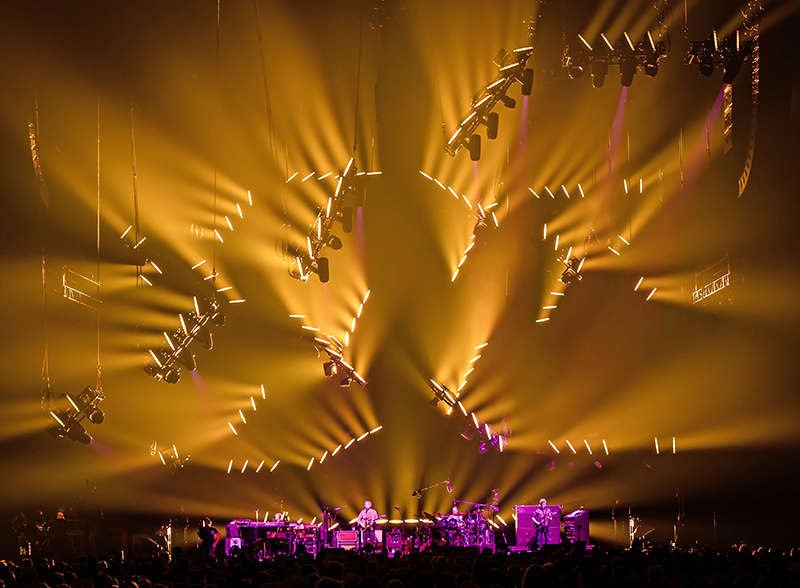
Talk about the flexibility of the automation of the lighting trusses in your design.
The flexibility is wonderful because we never know what automation is needed—a shape, move, or dynamic move. When it’s constantly moving and doesn’t stop, we refer to that as a dynamic move; then it just goes to a static shape. Whether it’s a smile, a frown, a rooftop, or some predetermined shape that we’ve built in, that’s a little more deliberate than those simple shapes. That all gets called on the fly, so we just need to be ready for anything basically. We trigger a lot of those automation moves from the lighting console itself, and then there are other more detailed sort of difficult moves that have to be triggered by Madison [Wade, Automation Programmer] from the [TAIT] Navigator console just for safety issues. So, if we’re in the middle of something, I can turn to Gif and I can say, ‘Hey, I want this shape now.’ Or ‘Hey, I want this dynamic move now,’ and he’ll get on the headset with Madison to run it.
Tell us about working with Madison Wade on the automation looks.
Before we started working with Madison, if we were in a shape and we wanted to go somewhere else, we would have to go to a home position, which we refer to as flat, first. Then from the home position go to the new shape or the new move. Madison has come in and just taken the automation to a completely new level and rewritten all the code that we used to use. Now no matter where we are, we can go anywhere without needing to go to that home position first. Which fits right into the mantra of organic, elegant, and fluid. Madison’s found a way to make it so much cleaner; just so much smoother.
Here’s the thing that I learned a long time ago: When you find the right people to work with, collaborating with the right minds, all working together, it can be an extremely powerful thing. For years, I’ve been looking at these automated trusses, they were my idea that I designed and had some basic concepts for them. Then, of course, over time, I thought that I had thought of everything; I couldn’t think of any more ideas for these things to do. Then you bring in people like Madison and Gif, and other folks. You listen to them, but you give them the freedom to create. I say to Madison all the time, ‘Hey, make me something new and I’ll tell you if I like it. He has just some really, really great ideas, and a lot of the ideas that are in the current automation came out of his brain. He’ll show me something, say, ‘I made this shape, and this is why it is the way it is.’ And I’ll look at it and I’ll go, ‘That is brilliant, I never would’ve thought of that.’ Some of those looks, that the collaborative people that I work with, came up with are my most favorite parts of our show. So, yeah, the lesson I learned a long time ago is to open your mind and work with other people and collaborate with people. Two heads are better than one, or five heads are better than one! It’s really, really paid off.
On a personal note, it took me a long time to get there. Back when I was much, much younger, I didn’t want to listen to anybody. I thought my ideas were the right ideas and I didn’t care what your ideas are. It was a long road for me to finally open up my mind. Look at what happens when you let down your guard and let other people into your world; it’s been an amazing experience since then.
Speaking of collaborations, talk about your long-time association with Andrew “Gif” Giffin, your Associate LD and Programmer.
I hired Gif in 2009 after a year where I had kept going through lighting programmers like water. They either didn’t work out or they got a designer gig. I reached out to our lighting vendor at the time and gave them the requirements that I was looking for—skillset, personality, loyalty, and someone long term. There’s a human factor that’s very important to Phish, we try to make sure we hire the right type of human being for our tour. Everyone’s got to be a team player, everyone’s got to be a nice person and have the skillset that you are required to have. They came back with one name, Andrew Giffin. I called him up and spoke to him for an hour, and didn’t necessarily know his skillset, but I knew he was the right kind of person for Phish. Right from day one, we got along great, and he really bought into the lighting concepts that I was trying to present visually and saw where I wanted to take it in the future. He was all in to help; to do the best he could to make our visions come true. He’s been with us ever since, and he is literally invaluable to me. I’ve learned as much from him as he’s probably learned from me.
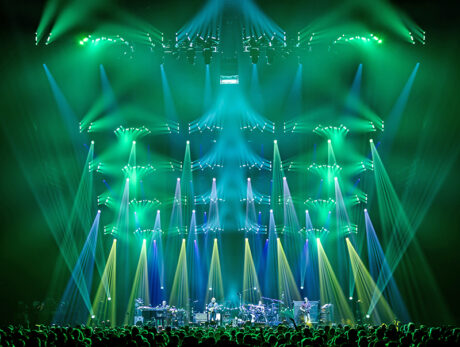
Talk about your use of color in your lighting designs.
Well, it’s kind of all over the board, so to speak. For a straight-up song, I will choose a color palette that I think fits the song. So, if it’s a ballad or something very, very soft and beautiful and gentle, I’ll stick around the blues, greens, and lavs and keep the pretty things going. But if it’s something that’s a little more upbeat, I’ll go a little warmer with the colors. The interesting thing when I say it’s all over the board is that when Phish jams, they jam into beautiful, and then they jam into evil, and they jam into pretty again, and they jam into ugly again. They jam into deep and raw, and then they jam into sort of ethereal kind of stuff. So during the jams, which can be up to 40 minutes long, I’ll use whatever color I deem necessary for that moment in the jam. I kind of break away from this need to stay in the cool palette or in the warm palette. Literally, the palette is decided moment by moment throughout the jam. I am playing the rig as an instrument, absolutely.
What’s something another designer might find interesting about your design?
The signature thing that I’m known for—that many other designers comment on when they come and see the show—is instead of pushing the button for the next cue on the downbeat, I push the button for the next cue five seconds before the downbeat. And that five-second cue lands on the downbeat, even though I pushed the button five seconds ago. People ask, ‘How do you push the button at a time that looked like absolutely nothing was happening, but five seconds later they all landed perfectly? How do you do that?’ I can’t tell you how I do that, but that’s my signature thing that I do. I’m not trying to pat myself on the back, but that seems to be throughout my career, the style that has blown many minds and impressed many lighting designers.
I remember the first time Gif saw me do it, he was just like, ‘What the heck?’ And recently Butch Allen came and saw a show, and his first comment was, ‘That’s next level, I don’t even know how you do that.’ That’s what caught his eye was that style. Not triggering the next cue on the downbeat, but just hitting the button at what looks like a random time to everybody else and having the lights go boom, bam, and land right on the downbeat. It’s an eyeopener for a lot of people, so I guess I just know the timing in my head well enough that I’m able to do that.
What are some of your key gear choices for Phish?
In the past we’ve selected fixtures based on the trick set that they have. We have a few things that we absolutely need the fixtures to be able to do that a lot of fixtures don’t do. Like putting fade time on the gobo wheel itself, not the rotating gobo, and being able to rotate the wheel at a fixed amount of time that is designated by the console, not designated by the fixture. A lot of manufacturers don’t want to let you do that because they’re afraid you’re going to leave the wheel halfway between two gobos and melt them. They don’t let you control that. I’ve always tried to choose fixtures where we can take control of that. I liked the iFORTE, and Robe was happy to write us our own firmware for iFORTE. They eventually put it into the released firmware so that the light could do that particular trick. So, a little collaboration and teamwork and everybody’s happy. Another one I like is the MegaPointe, I think it is the best hybrid out there. It’s what they look like when they’re in spot mode, not beam mode. The MegaPointe is really bright with a really good gobo package in spot mode. They all look good in beam mode, but it looks good in spot mode. Then the Spiider, we just really like the way it looks, and we like the multi pixel effects that it can do, and it’s the right size for Phish.
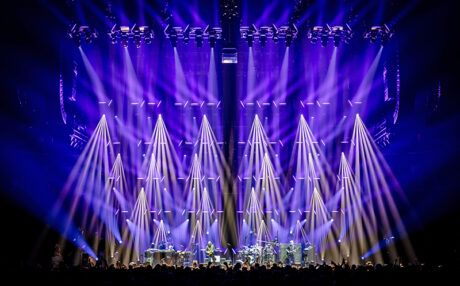
Why did you choose to switch from the Robe Tetra2 to the TetraX luminaire?
The Tetra2 has good color, it’s bright, and easy to control from the console, but with the TetraX now you have a Tetra that tilts and spins. At first it was, ‘it spins. Let’s use it.’ Because you spin it like a propeller, that’s going to look really cool. Then you learn later when you play with it that it’s not spinning it that is necessarily the cool stuff, it’s building shapes with them. That’s more impactful, the more subtle stuff. So, if you had eight next to each other and you tilted one a little bit one way and then the other a little bit the other way, and then one a little bit one way and stored that and you made a little zigzag. Then when you run effects through it, it’s not a straight line, it’s a zigzaggy line. The little static shapes that we can make with them are what I think is the most impactful use of those. Yes, when we spin them, a million percent and they go crazy and look like helicopters, that’s great, and the audience loves it, it is a great huge moment. But it’s the more subtle, elegant stuff that you can do with them that we really like.
Then you have the GLP JDC1 LED Hybrid Strobes, how do you use those?
I never strobe them; I just use them as block LEDs. I use them for accents and hits, so I can just push a button and flash them. I can make them whatever color I want and flash them on down beats, bang, bang, flash, flash. But I never run them like traditional strobes going, crazy.
Why was Gateway Studios & Production Services the right vendor for this tour?
We have nice ties with them, with Trey Kerr. He’s been on tour with us for many, many years in various positions, and now having started up Gateway, we knew he would be a good go-to. The timing was right, we knew we needed to make a change. You roll the dice. They’re a brand-new company, you don’t really know what kind of support you’re going to get from them, but as a brand new company all their gear is brand new. We had confidence in Trey, and they were willing to work with us to get what we needed. They asked us about what to buy that we wanted. The support and the service from Gateway has been amazing.
And Jesse Sandler is the Production Manager…
I love Jesse, he is wonderful, and he is super supportive. Anything we need, he’ll make it happen, no questions asked. He doesn’t even ask, ‘Why do you need this?’ He says, ‘You need it, I’ll make it happen.’ Really, it’s been a great experience working with him. And over my 35 years, I’ve worked with many, many, many production managers; he’s at the top of my list.
I also just want to take the opportunity to also say everybody on this tour is great, but especially my entire lighting crew—they’ve been with me for a long, long time. They’re loyal, and they love being on Phish. It is great that when we get people that we like—and that like us—they stick around for years and years. They’re almost family at this point and we’re very fortunate to have them. And Madison in automation falls right in there as well.
The reason Phish works so well is because it’s a team, it’s teamwork. It’s not just one person dictating to everybody else. We all work together, we all listen to each other, we all take each other’s suggestions. As an example, when we were deciding what the next profile was going to be, we looked at several lights. My Lighting Tech, Kurt [Thormodsen], who opens them up when they break on tour and fixes them, he took apart the lights we were considering, and looked at how they were built. He commented, ‘This could be a problem down the road.’ Or ‘It would be really hard for me to fix the color flags on this thing while we’re on tour.’ Or ‘This is a really well-built light; I’m looking inside and everything just seems really well-thought-out.’ That was his report for the iFORTE. So, we listened to him. None of us, Gif, myself, or others, we don’t know how to take apart a light and look at it and decide if it’s well-built or not from a technical standpoint. We listen to our crew’s thoughts; we take that into consideration when we make decisions. It’s a team and that’s why it works.
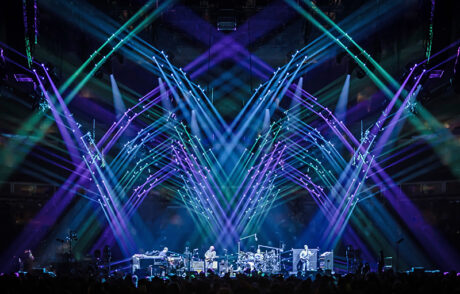
ANDREW “GIF” GIFFIN
Lighting + Motion Programmer / Associate Lighting Designer
Talk about creating the visual environment of the show.
There’s no set or scenery, no dancers, and no video content. Lighting is the visual experience. That’s liberating in a lot of ways, but it’s also a lot of responsibility. And with no setlist, it’s a real programming challenge since it’s all got to be able to be punted easily. Chris doesn’t have time to change pages. The band very quickly changes direction, and he’s got to have everything accessible in front of him all the time. There’s only so much real estate on the console, and a human wingspan is only so big. There’s a lot of clever logic that I’ve put into the lighting programming to make it all accessible, without changing pages. Like certain cues are aware of the state of other cues and what else is running and change their behavior appropriately just to be able to get everything rapidly.
Talk a little more about the collaboration with Chris in terms of your creative process and programming.
Our favorite word is ‘and’. One of us will come up with an idea and then the other one will go, ‘and it should do this’. That gets bounced back and forth. Before you know it, we’ve got some fully baked concept. One of the really great things about the way Phish works is because it’s not a traditional show with a traditional setlist, the programming’s never done. We don’t have to just get through all the songs on the list and then send it on its way. There’s always the ability to add new material. We love bouncing ideas off each other, and we’ll always try to take it a step further.
During the show I’m primarily dealing with automation, but we have this great system going with the networked MAs where if one of us comes up with an idea for something new, I’ll program it blind at front of house, using MA 3D to visualize. If inspiration strikes, or I know that the band is planning on doing something unique later, I can proactively make that cue and then it immediately appears on Chris’s console. He’ll always find the exact right moment to use it. I don’t imagine that there are many other tours that require adding programming in the middle of the actual live show.
We only have 28 songs programmed, and that’s only the part of each song that the band’s most likely to play consistently. Then once they take off into a jam, all bets are off. The thing I’m most proud of technically is the ability to keep the lights focused on the stage as the trusses are moving through space. Features in the console do the XYZ coordinates, so you can keep the lights focused on a location in space, even as the fixture itself is moving. We’re using PosiStageNet (PSN) protocol from Navigator to feed back to me where all the trusses are, and that updates live in the 3D model.
But the challenge was using the same fixtures to light the stage positions, which use the XYZ logic, and then also have those fixtures do big flyouts into graphic aerial patterns and sweep across the crowd, which is pan and tilt logic in the console. Then even if the trusses have now moved, when it’s time for those lights to return to the stage, we’ve got a great method, taking the right path and doing it smoothly, which was a lot harder than you think it would’ve been. It took a lot of effort to get it right, especially since the cues must be able to play in any order, and now that we do, it’s really impressive. That’s one of those things that when you show an experienced production person, especially a lighting programmer, what’s going on you just see their eyes grow.
If I didn’t point it out, you’d probably never notice it. Since all the trusses move, we absolutely needed a means of keeping the lights focused on the stage. But we also maintain this classic aesthetic as they rise and fall back, even as the structure changes form.
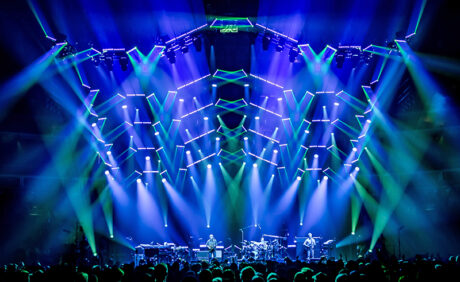
Talk about controlling the truss automation.
We have three different ways to control the automation. We have console control by which I’m choosing a translation and a rotation for each stick of truss. We have 30 individual sticks of truss of varying lengths; none of it’s pinned together. Every truss has two TAIT Kinesys Apex Hoists. When I’m in console mode of thinking about the trusses as having a translation and a rotation, Navigator does the calculations to determine what that means to each of the two hoists on each pod to make it go where I’ve requested it to be.
Then there are a lot of cues, especially some of the aggressive ones that are very fast or at very steep angles that are programmed in Navigator directly. Madison and I coordinate passing control back and forth during the show. I’ll say, for example, ‘I’m going to Smile Stagger, and once you see me get there, you go to the Galactica position please’.
Recently, Madison had this idea to start controlling individual hoists from the lighting console. So, instead of a translation and rotation, we can now actually drive each hoist directly, but that’s very new and something we’re still tinkering with. It opens a whole new world of possibilities. It’s incredibly useful to have different ways to control the things depending on which tool happens to be the best for any particular cue.
Talk about some of your key gear choices.
The iFORTEs are fantastic. Those are not just the workhorse gobo light, they’re also what key lights the band. And it is great they are IP rated because we do a lot of outdoor shows and they’re on the downstage most truss that gets rained on occasionally. The real star of the show, now, is the TetraX, which we have 144 of them. What we’re really enjoying about the TetraX is obviously they’re a linear fixture that, in addition to tilt, has continuous pan ability. We use the continuous pan occasionally for sure, but where they’re really paying off is we’ll put them in carefully conceived static positions with a pan and a tilt, just like a normal moving light, and then only turn on a carefully selected group of pixels, not the whole bar. If you do that and zoom all the way down, now suddenly, you’ve got hundreds and hundreds of individual little beams of light. Don’t think of it as a sheet of light, like a normal strip light, but think of each pixel as an individual beam, and they are focusable enough and bright enough. Since each pixel has its own lens, if you shut some of them off, they disappear. We’re making infinitely-variable looks this way. Don’t get me wrong, we do the big badass sheet look with them often as well, but that’s only part of their utility to us.
What’s something another lighting person might notice about the design?
I would say the layering of it. The way I’ve got this programmed is very intentionally set up for Chris to be able to layer things. Sometimes he’ll surprise himself, and me, when he finds a way to layer lighting cues in a combination that we had never thought of in previz. He’ll find the right moment to do it in the show and we’ll just look at each other and go, ‘that’s incredible!’. But the layering doesn’t stop there because now we’ve got potentially dozens of cues all running on top of each other and interacting with each other, then the TetraXs are potentially moving, and the trusses are moving. We’ve got basically three layers of motion, with the moving lights and TetraXs and the trusses physically moving through space. So, it never gets stale, even with three plus hours of music every night. I think that we can keep it so varied because of all the layering opportunities. A lot of our fans come to many, many shows, and it’s really nice when they’ll comment on something saying, ‘Hey, I’ve never seen that before’. And sometimes, we hadn’t either.
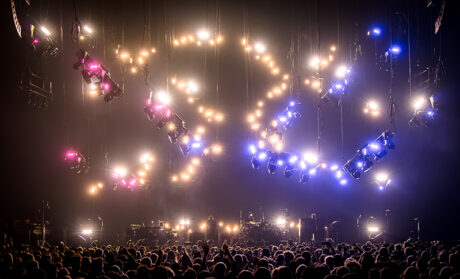
TREY KERR
GSPS CEO / Video Director
Tell us a bit about ensuring the broadcast-quality capture and cuts of the Phish shows.
Every Phish show is broadcast at livephish.com, which is their own service that allows Phish fans to pay to watch the shows they can’t be at. It’s very successful because Phish does a different show every night, and they have fans that want to see every single show. We’ve really been able to be at the forefront of the video technology with how we do it. The big thing is everyone involved on our video team has a broadcast background in some sense and understands the broadcasting element, which is a much bigger beast than just the live I-Mag element of video.
When you’re doing a broadcast show, it’s very much about telling a story with what the band’s giving you, what they’re doing, and the environment. With Phish, lighting is such a huge element to what we do. We’ve got four guys on stage that are making music, and then we have Kuroda. So, when you look at the broadcast side of what we do, there’s five elements. There’s the bass player, there’s the guitar player, there’s the drummer, there’s the piano player, and then there’s the lighting rig. If you take all five of those, and you equally distribute them, I have found it to be a very successful balance for the broadcasts.
What is some of the technology you’re using to capture the shows?
Everything we do is in 4K HDR. When we took over the Phish video in 2018, the big thing that we were doing that no one else did was 4K HDR; it’s the extra resolution and what really makes the difference, especially when you’re talking about a show that’s so lighting heavy and intricate, is the HDR aspect of that, which is the high dynamic range. That’s the key. The 4K and HDR element side is something that we really pride ourselves in, not only with Phish, but with Gateway. It’s used mostly in film and television and not on most live rock ‘n’ roll shows. But, if we can do it, we should be doing it. Everything we capture and do is 4K HDR. At Gateway, we built out a broadcast trailer specifically designed for Phish. The first two thirds of it are state-of-the-art broadcast trailer with the guts being mostly Ross Video and Panasonic. Then the back third is audio.
We have a phenomenal relationship with Panasonic. On Phish, we built the show around a lot of robo cameras from Panasonic. Then we do a handheld camera on stage, a handheld in the pit, and a long lens at front of house. I use between 12 and 17 cameras generally. Also, Ross is phenomenal. They’ve been a great partner as well, and we love having them on board with us. We use Ross in terms of routers and switchers; generally, what our systems are built around. And we like Blackmagic too. The pieces that we use from Blackmagic are tried and true.
Why was Gateway Studios & Production Services the right vendor for this tour?
Chris is one of the best in the business, and he is always pushing the envelope. Being able to work with him and Gif and get them what they need to be successful and be a part of building such an incredible show—from a Gateway perspective—that’s very special for me and very cool. With Gateway, we are not the biggest company. We’re not the smallest either. What we pride ourselves on is customer service and treating our customers like they’re our only customer. When speaking with a band’s management, they’re often blown away that we’re able to give them the quality of care that we give them while also having 40 other clients. We try to treat all our clients that way.
Our company was built by roadies for roadies, and every single client that we work with, we try to treat like we’re out there on the road with them. There’s nothing worse than being out on the road having problems and feeling like you’re left hanging; Gateway will never leave someone without support. Our company is absolutely built upon customer service. I think from a Phish perspective, Gateway was right because they not only appreciate that support but have to be able to count on that support. Since Phish is always pushing the envelope, they need a vendor that they can rely on and that they emphatically trust, that’s going to get the job done. I am proud that Gateway is trusted to be on Phish.
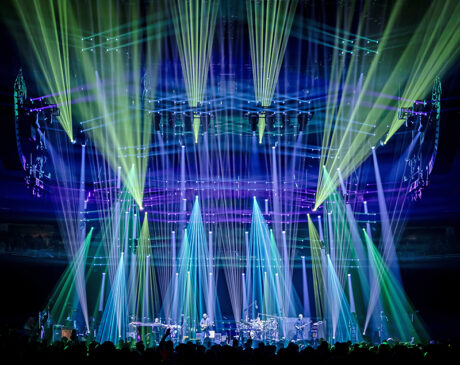
JESSE SANDLER
Production Manager
Talk about the production flexibility you need to address playing varying venue types.
The show, currently, was designed for an A-market arena. Mainly for trim heights. The way the show is designed is we have our A-level arena show, or big shed show, where we can hang the entire show and move all 30 of our automated lighting trusses up and down. That’s our primary show. Then our second option is a staggered show look where we remove all the automation. We basically take all the lighting trusses and just connect them together as straight trusses, and then we stagger the trusses where the downstage truss trims at its highest, and then everything else staggers back from there. That’s the show we use when either the venue won’t support the rigging, or we don’t have the trim height required to move the trusses enough and it really limits Chris and Gif’s ability to make the motion show work. So those are the A and the B versions, which are the two most used show setups.
For example, last spring we played the arena in Seattle, so we had our full A show in the best environment, then we played the Hollywood Bowl, which is obviously a much different venue. We also played the Greek Theatre in Berkeley. That gives you an idea of the extremely different venues we play on one leg of a tour. So, we then have another option to use motion, a third version, which is sometimes when we play venues that have enough height, have enough capacity, but the width of the stage isn’t enough to fit our 62’ mother grid trusses. This third option, in that scenario, is we cut the 5’ lighting trusses off the ends and we cut the subsequent mother grid trusses that are associated with the smaller 5’ lighting trusses. We basically do a compressed version of the motion show; we rarely do that, but occasionally we have to. One of those three versions of the show seems to work everywhere we play. We need to have options since Phish loves to play the sheds, and love to play the older venues, and we have some arenas thrown in as well.
What’s something that people may not know about the production of Phish?
People probably don’t know, in the general sense, how complex; how complicated; how much work really is put into the programming of putting the lights and the motion together. Chris, Gif, and Madison [Wade] have taken it upon themselves to master this balance between motion controlling lights and just all the XYZ stuff that they do to really make the show something spectacular and different every night.
As a production manager, to me, that’s one of the most interesting parts, how far they’ve taken the technology with the grandMA, the TAIT Navigator system, and how they keep pushing the limits of actually what is possible and what it can all do. It’s pretty amazing what these guys are doing. A couple of years ago we brought Madison in as our Navigator Operator, and he has definitely elevated how we operate the automation. Chris and Gif are so creative and with Madison’s deep knowledge of Navigator, they now push things in ways that they wouldn’t have known were possible before. It’s interesting and cool to see how automation is now becoming more of an art form, more of a design form than only a technical aspect.
How has the support of your vendors Gateway and TAIT been?
Gateway does lighting and video and they’ve been great. We moved over to them a year ago, an emerging company that is doing a lot of work, and they’ve been really good to work with. Everybody who works there is on point, and we get very good service, so Gateway is definitely a great fit for our tour. And then TAIT does all our automation, and Clair is our audio company, and both are also great at supporting us.
Any concluding comments?
It’s really my pleasure to work with the hardworking and dedicated Phish crew. People are what make this show happen and the band definitely cares about the people that work for them. That is why most of our crew have stayed with the tour for so long. I am thankful be a part of such a great team.
PRODUCTION TEAM
- Tour Manager: Richard Glasgow
- Production Manager: Jesse Sandler
- Lighting Designer/Director: Chris Kuroda
- Lighting + Motion Programmer/Associate Lighting Designer: Andrew Giffin
- Automation Programmer: Madison Wade
- Lighting Crew Chief: Casey Fleming
- Lighting Technicians: Kurt Thormodsen, Amanda Vargas, Madison Gray, Andrew Kenneth
- Video Director: Trey Kerr
- Video Crew Chief: Conway McDonald-O’Lear
- Video Engineer: Wes Petty
- PTZ Operator: Andrew Wilson
- Camera Operators: Jeff Vinson, Andrew Smith, Brandon Fedde
- Graphics: Danny Clark
- Automation Operator/Crew Chief: Madison Wade
- Automation Rigger: David Bainbridge
- TAIT Crew: Daniel Evans, Chastity O’Bradovich
VENDORS
- Lighting, Video, Rigging: Gateway Studios & Production Services, David Haskell, Acct Mgr
- Automation: TAIT, Alex Serrano, Acct Mgr; Francesca DeCicco, Project Mgr
GEAR
Lighting
50 Robe iFORTE
60 Robe Spiider
28 Robe MegaPointe
144 Robe TetraX
20 GLP JDC1 Hybrid Strobe
4 MDG theONE Atmospheric Generator
5 Lex Presidential 48-Way Power Distro
2 grandMA3 full-size Console
1 grandMA3 light Console
Video
Broadcast Trailer
1 Blackmagic Design ATEM Constellation 8K Ultra HD Production Switcher
1 Ross Ultirx 5RU Router Frame
2 Ross QE36 Ultrix Control Panel
2 Ross QE18 Ultrix Control Panel
4 Ross Ultrix I/O Card 16×16
2 Ross Open Gear Frame
20 Ross Open Gear 1×4 SDI DA Card
20 ShiedlRock 12G SDI Fiber Transceiver Card
1 Panasonic RP-150 PTZ Controller
2 Leader LV5600 Waveform Vector Scope
1 Clearcom Helixnet Intercom System
7 Atomos Shogun Stuido II Dual Record Deck
2 AJA Framesync HDR
5 Apple Mac Mini
1 Apple Mac Studio
2 Atomos Sumo 19” HDR Monitor/Recorder
3 55” Sony 4K TV
1 Tecnopoint DC10E Tuning Control Panel
Camera Package
5 Panasonic Ak-UC4000 4k Studio Cameras
6 Panasonic AW-UE150 4k PTZ Cameras
4 Black Magic Design Micro Studio 4K POV Cameras
Lens Package
2 Fujinon UA107x 4K Box Lens
2 Canon CJ24x7.5 4K ENG Lens
1 Canon CJ14x4.3 4K ENG Lens
Camera Support
1 Tecnopoint Tuning Floor Dolly 400
1 Tecnopoint Tuning Totem 50
1 Tecnopoint Tuning Totem 80
Rigging
82 CM Prostar 1-Ton Chain Motor
36 CM Prostar ½-Ton Chain Motor
9 CM Prostar ¼-Ton Chain Motor
Automation
60 TAIT Kinesys Apex Servo Hoist
1 TAIT Navigator
1 grandMA3 light Console
PHISH returns to NYC’s Madison Square Garden for a four-night New Year’s run starting December 28, 2023. The band will also be performing four consecutive shows at Sphere in Las Vegas in April.

